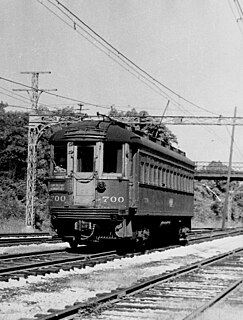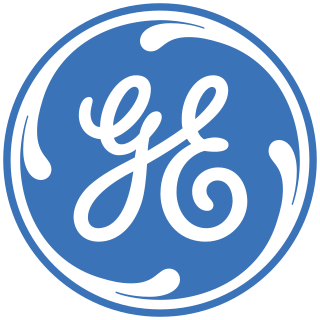
The Chicago Transit Authority (CTA) is the operator of mass transit in Chicago, Illinois and some of its surrounding suburbs, including the trains of the Chicago "L" and CTA bus service.

The PCC is a streetcar (tram) design that was first built in the United States in the 1930s. The design proved successful in its native country, and after World War II it was licensed for use elsewhere in the world where PCC based cars were made. The PCC car has proved to be a long-lasting icon of streetcar design, and many are still in service around the world.

The Yellow Line, alternatively known as the Skokie Swift, is part of the Chicago Transit Authority's "L" system in Chicago, Illinois. The 5.1-mile (8.2 km) route runs from the Howard Terminal on the north side of Chicago, through the southern part of Evanston and to the Dempster Terminal in Skokie, Illinois, making one intermediate stop at Oakton Street in Skokie.

The Purple Line of the Chicago Transit Authority is a 3.9-mile (6.3 km) route on the northernmost section of the Chicago "L" rapid transit system. Normally, it extends south from Linden Avenue in Wilmette, passing through Evanston to Howard Street, on Chicago's north side. In 2016, the average weekday boardings on the Purple Line was 10,187.

The Halton County Radial Railway is a working museum of electric streetcars, other railway vehicles, trolleybusses and buses. It is operated by the Ontario Electric Railway Historical Association (OERHA). It is focused primarily on the history of the Toronto Transit Commission and its predecessor, the Toronto Transportation Commission (TTC), with a collection including PCC, and Peter Witt cars, earlier streetcars and Gloucester series and Montreal-built subway cars.

A pantograph is an apparatus mounted on the roof of an electric train, tram or electric bus to collect power through contact with an overhead line. It is a common type of current collector. Typically, a single or double wire is used, with the return current running through the track. The term stems from the resemblance of some styles to the mechanical pantographs used for copying handwriting and drawings.

The Pink Line is an 11.2 mi (18.0 km) rapid transit line in Chicago, run by the Chicago Transit Authority (CTA) as part of the Chicago "L" system. It is CTA's newest rail line and began operation for a 180-day trial period on June 25, 2006, running between 54th/Cermak Station in Cicero, Illinois and the Loop in downtown Chicago. The route to the Loop follows tracks shared with Green Line trains on Lake Street, connected by the previously non-revenue Paulina Connector. In September 2012, the average weekday boardings on the Pink Line was 33,737. The Pink Line does not make any 'L' train transfers on the Douglas Branch. The Pink Line operates between 54th/Cermak and the Loop, weekdays from 4:05 a.m. to 1:25 a.m., and Saturdays and Sundays from 5:05 a.m. to 1:25 a.m.

Dempster–Skokie, formerly known as Dempster, or Skokie, is a station on the Chicago Transit Authority's 'L' system, on the Yellow Line at 5005 W. Dempster Street in Skokie, Illinois. It is one of three stops on the Yellow Line, and currently the terminus of line, although an extension of the line to Old Orchard Mall has been considered. It is one of two CTA rail stations in Skokie, and is at grade level. It is also one of two terminals that doesn't have a rail yard assigned to it. All 6 cars assigned to the Yellow Line are stored at the Howard Yard. The Skokie Shops are accessible only via the Yellow Line's tracks, but the shops do not function as a yard, only as a shop for rail cars. This station is one of two CTA rail terminals that does not have an island platform, the other being Cottage Grove on the Green Line. Passengers who wanted to return to Howard from this station after leaving a train arriving at this station had to always pay an additional fare.

The Fox River Trolley Museum is a railroad museum in South Elgin, Illinois. Incorporated in 1961 as R.E.L.I.C., it opened in 1966 and became the Fox River Trolley Museum in 1984.
The current rolling stock of the Chicago "L" rapid transit system consists of three series of railcars. The oldest series is the 2600 series which was built between 1981 and 1987 and refurbished between 1999 and 2002. The second series is the 3200 series, built between 1992 and 1994 and refurbished between 2015 and 2018. The third and newest series is known as the 5000 series; built between 2009 and 2015, they feature new technologies such as LED color signs, security cameras, new seating configuration, AC motors, and date and time.

The 2400 series is a series of Chicago "L" cars built between 1976 and 1978 by Boeing-Vertol of Ridley Park, Pennsylvania, with shells fabricated by Sorefame. 200 cars were built and on October 31, 2014, the series was retired from revenue service. These cars were in service for 38 years.

The 5000 series is a series of Chicago "L" car built by Bombardier Transportation of Plattsburgh, New York. A $577 million order for 406 cars was placed in 2006. In July 2011, the CTA ordered 300 more cars for $331 million as an option on the first contract.

The 2000 series was a series of Chicago "L" car built in 1964 by Pullman-Standard of Chicago, Illinois. 180 cars were built.

The 1–50 series was a series of Chicago "L" cars built by the St. Louis Car Company in 1959 and 1960. Unlike cars in the similar 6000 series, which were designed for married pair operation, the 1–50 series cars were double-ended to facilitate single car operation. There was a limited need for single cars, however, so cars 5, 7, 9, 11, 15, 19, 21, 23, 24, and 31 were later rebuilt as married units and were renumbered 61a/b–65a/b.

The State-of-the-Art Car (SOAC) was a heavy rail mass transit demonstrator vehicle produced for the United States Department of Transportation's Urban Mass Transportation Administration in the 1970s. It was intended to demonstrate the latest technologies to operating agencies and the riding public, and serve to promote existing and proposed transit lines. A single married pair was produced by the St. Louis Car Company in 1972. It operated in intermittent revenue service on six rapid transit systems in five United States cities between May 1974 and January 1977. Since 1989, the two cars have been on display at the Seashore Trolley Museum in Kennebunkport, Maine.




















